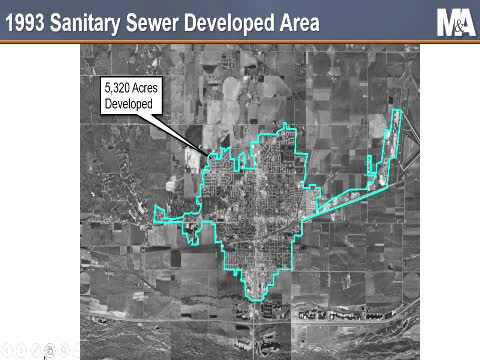Kearney outlines growth potential with updated sanitary sewer and water infrastructure plans
May 16, 2025 | Kearney City, Buffalo County, Nebraska
This article was created by AI summarizing key points discussed. AI makes mistakes, so for full details and context, please refer to the video of the full meeting. Please report any errors so we can fix them. Report an error »

During the Kearney Planning Commission meeting on May 16, 2025, city officials discussed significant advancements in the sanitary sewer infrastructure that have facilitated Kearney's growth over the past decades. The meeting highlighted the evolution of the city's sewer capabilities, which have expanded from approximately 5,300 acres in 1993 to nearly 10,000 acres today, equating to about 15.5 square miles of developable area.
The discussions centered around historical studies, particularly the North Sanitary Sewer Study initiated in 1992, which laid the groundwork for much of Kearney's development. This study enabled the construction of essential infrastructure, including gravity sewer lines and lift stations, which have been crucial for managing waste and supporting new subdivisions. The planning commission emphasized that without these studies, many areas, such as Lighthouse Point and Kelly Raps Subdivision, would not have been developed.
City officials also presented data on the current capacity of the wastewater treatment plant, which operates at 64% of its 5.9 million gallons per day capacity. This leaves room for an estimated population growth of up to 43,000 residents, indicating that Kearney is well-positioned for future expansion. The treatment plant has the potential to handle up to 18 million gallons per day, further supporting the city's growth ambitions.
In addition to sewer infrastructure, the meeting addressed the city's water supply capabilities. Kearney's water system, fed by two well fields, has a total capacity of 29 million gallons per day, with an average daily demand of only 6.1 million gallons. This surplus capacity ensures that the city can meet the needs of both residential and industrial developments.
The planning commission underscored the importance of proactive infrastructure planning, noting that Kearney's foresight in developing its sewer and water systems has been a key factor in its continued growth. As the city looks to the future, officials are committed to maintaining and expanding these essential services to accommodate new developments and enhance the quality of life for residents.
The discussions centered around historical studies, particularly the North Sanitary Sewer Study initiated in 1992, which laid the groundwork for much of Kearney's development. This study enabled the construction of essential infrastructure, including gravity sewer lines and lift stations, which have been crucial for managing waste and supporting new subdivisions. The planning commission emphasized that without these studies, many areas, such as Lighthouse Point and Kelly Raps Subdivision, would not have been developed.
City officials also presented data on the current capacity of the wastewater treatment plant, which operates at 64% of its 5.9 million gallons per day capacity. This leaves room for an estimated population growth of up to 43,000 residents, indicating that Kearney is well-positioned for future expansion. The treatment plant has the potential to handle up to 18 million gallons per day, further supporting the city's growth ambitions.
In addition to sewer infrastructure, the meeting addressed the city's water supply capabilities. Kearney's water system, fed by two well fields, has a total capacity of 29 million gallons per day, with an average daily demand of only 6.1 million gallons. This surplus capacity ensures that the city can meet the needs of both residential and industrial developments.
The planning commission underscored the importance of proactive infrastructure planning, noting that Kearney's foresight in developing its sewer and water systems has been a key factor in its continued growth. As the city looks to the future, officials are committed to maintaining and expanding these essential services to accommodate new developments and enhance the quality of life for residents.
View full meeting
This article is based on a recent meeting—watch the full video and explore the complete transcript for deeper insights into the discussion.
View full meeting
